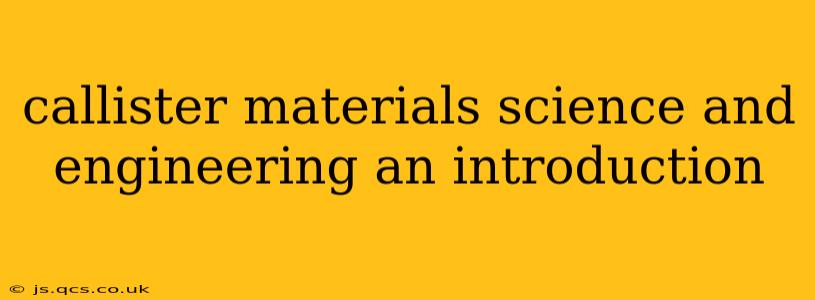Callister's "Materials Science and Engineering: An Introduction" is a cornerstone textbook in the field, renowned for its comprehensive coverage and clear explanations. This guide delves into the book's key aspects, exploring its structure, content, and its enduring value in the world of materials science and engineering. We'll also address some frequently asked questions surrounding this widely used text.
What Makes Callister's Textbook So Popular?
Callister's book stands out due to its exceptional balance of theory and practical application. It doesn't just present abstract concepts; it connects them to real-world examples, making the material relatable and engaging for students. The clear writing style, coupled with abundant illustrations and diagrams, simplifies complex topics, making them accessible even to those with limited prior knowledge. Its comprehensive coverage of various materials and their properties makes it a valuable resource throughout an undergraduate materials science curriculum.
What are the Key Topics Covered in Callister's Book?
The book systematically covers a wide range of topics essential for understanding materials science and engineering. Key areas include:
-
Structure of Materials: This section explores the atomic structure of materials, crystallography, and different types of bonding. Understanding these foundational concepts is crucial for comprehending the properties and behavior of materials.
-
Mechanical Properties: This section delves into the mechanical behavior of materials, including concepts like stress, strain, elasticity, plasticity, fracture toughness, and fatigue. Real-world examples illustrate how these properties influence material selection in engineering applications.
-
Failure of Materials: Understanding how and why materials fail is paramount in engineering design. This section covers various failure mechanisms, such as fatigue, creep, and stress corrosion cracking.
-
Phase Diagrams: Phase diagrams are essential tools for understanding the relationships between temperature, composition, and phase transformations in materials. Callister provides a clear and comprehensive explanation of these diagrams and their applications.
-
Phase Transformations: This section explores the different phase transformations that materials undergo, such as solidification, precipitation, and diffusional transformations.
-
Thermal Properties: This explores thermal expansion, heat capacity, and thermal conductivity, highlighting their importance in various applications.
-
Electrical and Magnetic Properties: This section covers the electrical and magnetic behaviors of materials, encompassing concepts like conductivity, resistivity, and magnetism. Applications of these properties are discussed extensively.
-
Optical Properties: This section explores how materials interact with light, including concepts such as refraction, reflection, and absorption.
-
Polymer, Ceramic, and Composite Materials: The book dedicates significant sections to these crucial material classes, detailing their properties, processing methods, and applications.
-
Material Selection and Design: This integrates the knowledge gained throughout the book to guide students on selecting appropriate materials for specific engineering applications.
What is the Difficulty Level of Callister's Book?
The book is designed for undergraduate students, but its comprehensive nature makes it a valuable resource even for graduate students and professionals. While the concepts covered are inherently complex, Callister's clear writing style and numerous examples help make the material accessible. Students with a strong foundation in chemistry and physics will find the transition smoother.
Is there a Solutions Manual for Callister's Book?
While a comprehensive solutions manual isn't publicly available, numerous study guides and problem solution sets exist. These resources can prove invaluable for students seeking additional practice and clarification on problem-solving strategies.
How Does Callister's Book Compare to Other Materials Science Textbooks?
Callister's book is widely considered one of the best introductory texts in the field due to its clarity, comprehensive coverage, and balance between theory and application. While other excellent materials science textbooks exist, Callister's often stands out for its accessibility and pedagogical approach.
What are the prerequisites for using Callister’s book effectively?
A solid foundation in basic chemistry and physics is highly recommended before tackling Callister's "Materials Science and Engineering: An Introduction." Familiarity with fundamental concepts like atomic structure, bonding, and basic mechanics will greatly aid comprehension.
In conclusion, Callister's "Materials Science and Engineering: An Introduction" remains a highly valued and influential textbook. Its comprehensive approach, clear explanations, and abundance of practical examples make it an indispensable resource for students and professionals alike seeking a deep understanding of this crucial engineering discipline.
